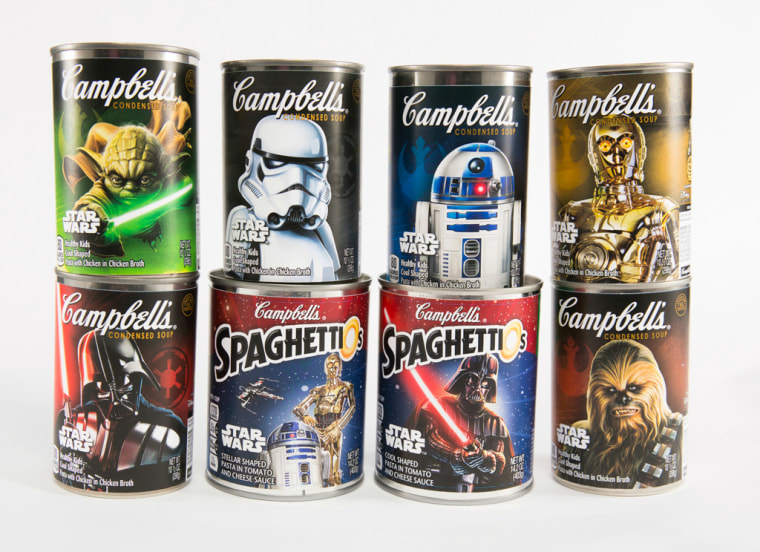
Instead of noodles and stars, you’ll find Darth Vader- and Stormtrooper-shaped pasta inside the cans of Campbell’s new Star Wars soups—but that’s not the only difference.
With the launch of the limited-edition line, Campbell’s also rejiggered the chicken broth recipe for its kids' line, narrowing down the number of ingredients from 30 to 20, for a “cleaner label” product that’s becoming more of a norm on supermarket shelves. Elements like MSG and maltodextrin have been nixed, while ones like chicken stock, enriched pasta, carrots, chicken meat and chicken fat remain.
“When we make a change to a recipe that is as loved as our kids’ chicken and pasta soup, we work very hard to keep the flavor and texture consistent, because we know just how important that is for people, especially kids,” Anna Burr, director of communications for the company, told TODAY.com. “We know cleaner-label food is something parents are looking for.”
Related: Try this Thai-inspired coconut curry chicken noodle soup
Indeed, inspired by food activists like Michael Pollan, consumers are seeking out labels with shorter ingredient lists, with more back-to-the-basics items that aren’t hard to pronounce.
“In order to keep sales from taking a downward turn, these big companies know they have to adjust and re-formulate recipes that previously were flying off shelves,” says Joy Bauer, TODAY nutritionist and founder of Nourish Snacks.
Frances Largeman-Roth, RDN, nutrition expert, author and TODAY contributor, agrees: “It goes to show that big food is finally listening to consumers. It’s great to see a big company like Campbell’s make these changes and clean up their products. They are essentially following in the footsteps of brands like Annie’s, who have been leaders in the natural and organic space for years.”
Examples of big names cleaning up their tried-and-true recipes are endless: Nestlé’s Hot Pockets and DiGiorno frozen pizzas will contain no artificial ingredients by end of year, General Mills removed GMOs from Cheerios, and Kraft Foods just famously replaced the synthetic color and artificial preservatives in its mac and cheese.
Bauer points out that most of the nixed ingredients were not necessarily harmful, but that “anytime people see long words they can’t pronounce in the ingredients list, they get worried about what it is.”
As for Campbell’s, the company is currently working on updating the recipes in more soups, and will roll them out as they are ready, Burr says. The majority of new products launching this year are already being made without things like high-fructose corn syrup, MSG, and artificial colors and flavors. The tricky part, of course, is painstakingly updating what’s inside those iconic red-and-white cans.
Watch: Katie Lee makes classic chicken noodle soup
“We are being very careful,” Burr says, “to ensure that any ingredient changes don’t affect the taste and texture of our beloved products.”
Here’s a point-by-point explanation of some of the removed items, according to information from the Center for Science in the Public Interest:
- MSG (monosodium glutamate): Eliminating this flavor enhancer was the biggest “no-brainer,” both nutritionists agree. According to the CSPI, “Careful studies have shown that some people are sensitive to large amounts of MSG. Reactions include headache, nausea, weakness and burning sensation in the back of neck and forearms. Some people complain of wheezing, changes in heart rate, and difficulty breathing.”
- Potassium chloride: A salt substitute used to reduce sodium and add potassium. “It’s recognized by the FDA as GRAS (generally recognized as safe), but it can add a metallic taste to foods, and people with kidney disease, or who are on diuretics, should minimize their consumption of potassium chloride,” Largeman-Roth says.
- Maltodextrin: A texturizer made from the starch of corn, potato or rice, but sometimes wheat. -
- Celery: If you’re scratching your head over why this one was eliminated, it’s because the child taste-testers didn’t like the flavor.
- Disodium inosinate and disodium guanylate: Enhancers that increase umami flavor; usually used with MSG; considered safe.
- Lactic Acid: Controls acidity, considered safe.